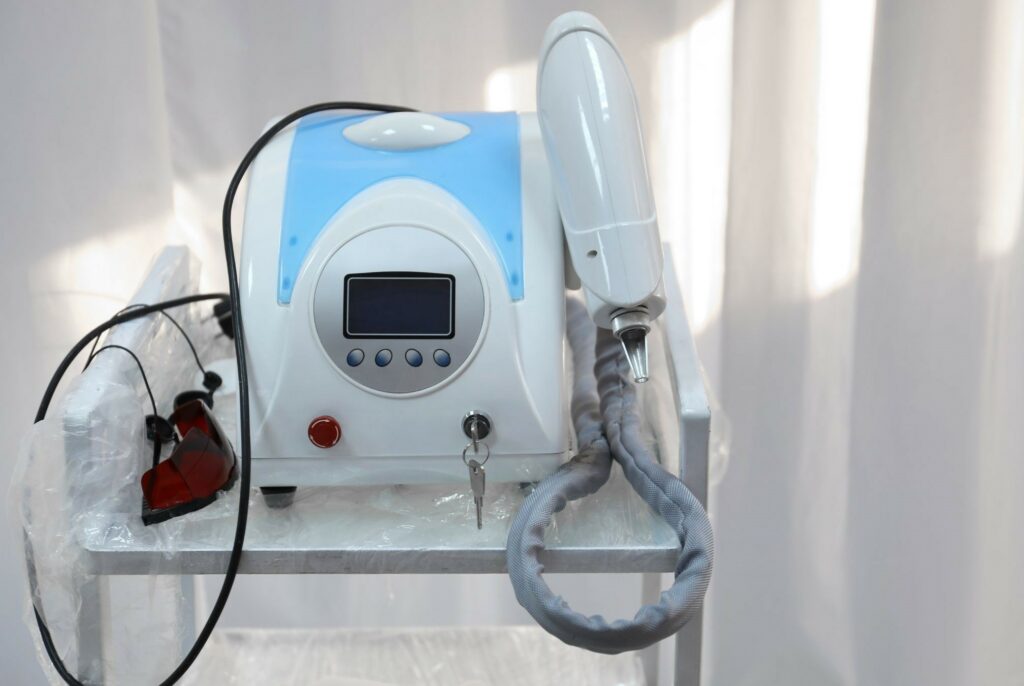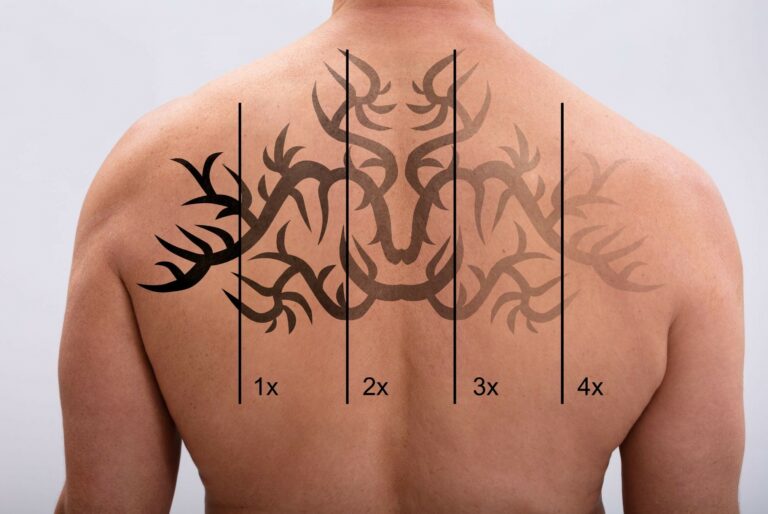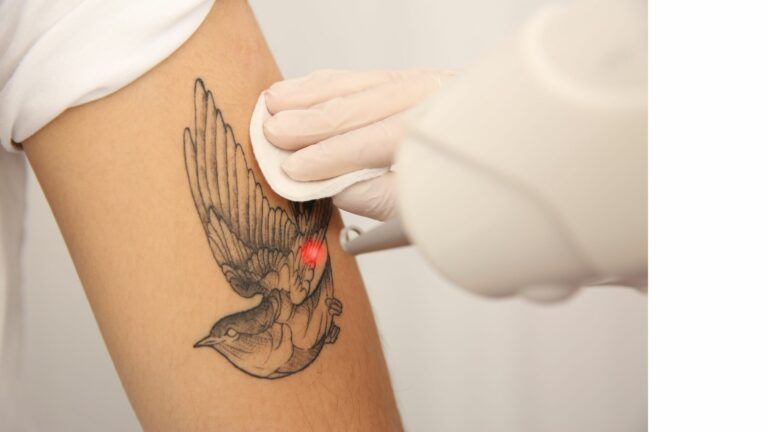Understanding the Tattoo Removal Process
Tattoos are a form of self-expression and often have deep personal meanings for the wearer. However, over time, people may regret getting a tattoo or wish to remove it for various reasons. The tattoo removal process is crucial to understand as it involves a series of steps and procedures that can have long-term effects on your skin.
Definition of Tattoo Removal
Tattoo removal is a process that involves removing or fading tattoos from the skin using different techniques. Tattoos are ink particles embedded in the skin’s dermis layer, which makes their removal challenging. These techniques aim to break down the ink particles into smaller pieces that can be eliminated by your immune system.
Brief History of Tattoo Removal
The practice of tattooing has been around for thousands of years, but tattoo removal has also been attempted throughout history. Early methods included using abrasives like sandpaper or salt to scrape off skin layers where tattoos were located. However, these methods were painful and often left scars.
In 1960, Dr.Roger Herron developed a method using thermal energy (heat) to remove tattoos. Later on, in 1983 Dr. Anderson and Dr.Parrish discovered that Q-switched lasers could effectively remove tattoos with minimal scarring.
The Importance of Understanding the Tattoo Removal Process
It’s important to know what you’re getting into before undergoing any procedure, including tattoo removal. Understanding how tattoos are removed can help you make informed decisions about which method is best suited for your situation and what kind of results you can expect. Additionally, knowing about factors that affect tattoo removal such as color and size can help prepare patients beforehand about how many sessions they might need for complete removal.
Understanding the tattoo removal process is crucial for those who have a tattoo they no longer want. This understanding can help them determine the best method for removal, prepare appropriately for the process, and make informed decisions about their body.
Types of Tattoo Removal Methods
Tattoo removal has come a long way since the days of harsh chemical peels and dermabrasion. Nowadays, there are two main types of tattoo removal methods: laser tattoo removal and surgical excision. Both methods have their pros and cons, which we will explore in this section.
Laser Tattoo Removal
Laser tattoo removal is the most popular and effective method of removing tattoos. It works by using high-intensity light to break down the ink particles in the skin. The laser targets the ink pigment, causing it to heat up and shatter into tiny fragments that can be eliminated by the body’s immune system.

One major advantage of laser tattoo removal is that it is non-invasive, meaning there are no incisions or stitches involved. This results in less scarring and a shorter recovery time compared to surgical excision.
Laser tattoo removal also allows for precise targeting of specific areas of the tattoo, making it a good option for partially removing or fading tattoos for cover-up work. However, there are some downsides to laser tattoo removal as well.
It can be painful and may require multiple sessions spaced several weeks apart for full effectiveness. The cost can also add up quickly depending on the size and complexity of the tattoo, with an average cost ranging from $150 to $500 per session.
Surgical Excision
Surgical excision involves physically cutting out the tattooed skin with a scalpel under local anesthesia or sedation. This method is typically reserved for smaller tattoos or those in easy-to-reach locations on the body.

One advantage of surgical excision is that it usually only requires one session to remove the entire tattoo, making it a quicker option than laser removal for smaller tattoos. However, scarring is more likely with this method due to its invasive nature.
Another disadvantage is that the cost can be higher than laser removal due to the need for a surgical facility and possibly a specialist surgeon. The average cost of surgical tattoo removal is around $2,000 per session.
Overall, both laser tattoo removal and surgical excision are viable options for removing unwanted tattoos. However, it’s important to consult with a dermatologist or plastic surgeon to determine which method is best suited for your individual case.
Tattoo Characteristics
The Impact of Size, Color, Age, Location, and Depth on Tattoo Removal
The characteristics of a tattoo often determine the level of difficulty in removing it. The size of the tattoo is a significant factor as larger tattoos require more treatment sessions than smaller ones. Additionally, tattoos with darker colors such as black or red are easier to remove than those with lighter colors like yellow or green.
The older a tattoo is, the more challenging it is to remove because over time it fades and becomes harder to distinguish from the surrounding skin. The location and depth of the tattoo also play a role in its removal.
Tattoos on areas with thinner skin such as hands, feet or face tend to be harder to remove because there is less tissue to absorb the laser energy. Similarly, tattoos that are deeper within the skin require more laser energy for successful removal.
The type of ink used for the tattoo can also impact its removal process. Tattoos made with professional-grade ink are usually easier to remove than those composed of homemade ink which may have varying chemical compositions.
Patient Characteristics
The Role of Skin Type, Health Conditions, Age and Immune System in Tattoo Removal
Tattoo removal results depend on various patient factors such as age and immune system response among others. Skin type plays a crucial role in how well someone’s skin responds to treatment; people with fair skin typically respond better than those with darker complexions due to lower melanin content which reduces potential injury from heat exposure during laser treatment.
Any pre-existing health conditions may affect how well an individual responds to tattoo removal treatments too. People who suffer from conditions like diabetes or lupus may need extra care during their treatments while those who take certain medications such as blood thinners should consult their doctors before starting any kind of procedure.
Age affects how well tattoos can be removed. Younger individuals with tattoos that are not too old would have better success rates than older people due to the skin’s regenerative abilities.
The patient’s immune system also plays a role in tattoo removal. A strong immune system can help remove ink particles from the skin while a compromised one may lead to incomplete removal despite adequate treatments.
Preparation for Tattoo Removal Process
Consultation with a Dermatologist or Plastic Surgeon
Before proceeding with any tattoo removal procedure, it is essential to have a consultation with a dermatologist or plastic surgeon who specializes in tattoo removal. During this consultation, the doctor will assess your skin type, the size and location of your tattoo, and its characteristics such as color and age.
They may also inquire about your health history to determine if there are any underlying conditions that may affect the tattoo removal process. The consultation is an excellent opportunity to discuss your expectations and ask questions about the procedure.
Pre-treatment care instructions
Preparing for a tattoo removal procedure involves specific pre-treatment care instructions that vary depending on the type of treatment you choose. For laser tattoo removal, pre-treatment care involves avoiding sun exposure and tanning beds for at least four weeks before the treatment, discontinuing blood-thinning medications or supplements at least one week before treatment, and keeping your skin well-hydrated by drinking plenty of water. You may also need to shave the area where the tattoo is located.
For surgical excision of tattoos, pre-treatment care involves avoiding smoking and alcohol consumption at least two weeks before surgery and discontinuing blood-thinning medications or supplements at least one week before surgery. You may also need to fast eight hours prior to surgery.
Aftercare instructions
Aftercare is critical for optimal healing after any tattoo removal procedure. For laser tattoo removal, aftercare instructions include applying ice packs over treated areas for 10-15 minutes every hour for up to six hours following treatment and using prescribed ointments such as petroleum jelly or antibiotic ointment on treated areas as recommended by your doctor. Patients should avoid exposing treated areas to sunlight until fully healed.
For surgical excision of tattoos, aftercare instructions include keeping the wound clean and dry for at least 24-48 hours after surgery, avoiding strenuous exercise or heavy lifting for several days, and taking prescribed antibiotics and pain medications as directed. Patients should also avoid smoking or alcohol consumption during the healing process to avoid complications and promote faster healing.
Summary
Preparing for a tattoo removal procedure involves several steps, including a consultation with a dermatologist or plastic surgeon who specializes in tattoo removal to evaluate your skin type, tattoo characteristics, health history, and discuss treatment options. Pre-treatment care instructions may vary depending on the type of treatment you choose but generally involve avoiding sun exposure and blood-thinning medications.
Aftercare instructions are equally essential to ensure proper healing after any tattoo removal procedure. By following these pre-treatment care instructions and aftercare guidelines carefully, you can enjoy optimal results from your tattoo removal procedure.
Tattoo Removal Process Step-by-Step Guide
Removing a tattoo is not an easy task. It requires commitment, patience, and the right procedure to achieve the desired result.
Tattoo removal can be done using various methods, but laser tattoo removal is considered the most effective method with minimal risk of scarring or infection. Here is a step-by-step guide on how to remove your tattoo using laser technology.
Skin preparation
Before undergoing laser treatment, you need to prepare your skin for the procedure. You should avoid sun exposure and use sunscreen to protect your skin from UV rays for at least two weeks before the treatment. The dermatologist or plastic surgeon will also advise you to avoid blood thinners such as aspirin, ibuprofen, and alcohol as they can increase bleeding during the procedure.
It’s important to thoroughly cleanse the area of skin that will be treated with soap and water just before treatment. The dermatologist or plastic surgeon may also shave any hair in the area to ensure contact between the skin and the laser device.
Application of numbing cream or local anesthesia
Laser tattoo removal can be painful; therefore, a numbing cream or local anesthesia may be applied before the procedure begins. A proper application of topical anesthesia (lidocaine) or injections (lidocaine hydrochloride) ensures that discomfort is minimized during this process. Depending on your pain tolerance level and where your tattoo is located on your body, it might not be necessary for you to apply this type of medication.
Laser treatment session
During laser treatment sessions, intense pulses of light penetrate deep into your skin tissue and break up the ink particles in your tattoos into smaller pieces that are then removed through natural processes by lymphatic system. The number of sessions required depends on factors such as size of tattoo being treated , coloration (black ink tattoos are easier to remove than colored tattoos), and age, which can also affect the ink’s ability to be removed. During each session, you’ll feel a warm sensation and experience some discomfort.
Pain is subjective and varies from person to person. It is important to communicate your level of discomfort or pain throughout the process.
Post-treatment care instructions
After your laser tattoo removal session, you need to follow some post-treatment care instructions. First and foremost, avoid sun exposure for at least two weeks after the procedure as UV rays can cause blistering and hyper-pigmentation. You should keep the treated area clean by washing it with mild soap and water, avoiding hot water or scrubbing until any scabs have healed.
It is important not to pick at any scabs or blisters that may form after treatment as it can lead to scarring of the skin. Use moisturizer regularly on treated areas as they heal.
You should also avoid strenuous activity for a few days after treatment, particularly if the tattoo was in an area that undergoes significant movement such as an arm or leg. Understanding the tattoo removal process is crucial for achieving optimal results while minimizing risks such as infection or scarring.
Lasers have become the most effective method of tattoo removal due their speed and minimal invasiveness compared to other methods like surgical excision. With proper preparation before laser treatment sessions with topical anesthesia , followed by post-treatment care instructions which ensure optimal healing , patients are able achieve desired results without serious complications.
Post-Treatment Care Instructions for Optimal Results
Now that the tattoo removal process is complete, it’s crucial to follow proper post-treatment care instructions to achieve optimal results. The following are some essential post-treatment care instructions:
Avoiding Sun Exposure
After a laser treatment session, the treated skin area becomes sensitive and prone to sunburn and hyperpigmentation. As such, it’s essential to avoid direct sunlight exposure for at least four weeks after each treatment session.
If you must go outdoors during the day, ensure that you apply a broad-spectrum sunscreen with an SPF of at least 30 on the treated area before going out. Wearing protective clothing such as long-sleeved shirts and hats can also help protect your skin from UV radiation.
Maintaining Hygiene
Maintaining proper hygiene is vital in ensuring that your skin heals properly after each laser treatment session. You should keep the treated area clean by gently washing it with mild soap and water two times a day.
Avoid scrubbing or rubbing the treated area vigorously as this may cause skin irritation. It’s also advisable to avoid taking hot showers or baths for several days after each laser treatment session as this can increase skin sensitivity.
Use of Prescribed Ointments
Your dermatologist or plastic surgeon may prescribe ointments to apply on the treated skin area after each laser treatment session. These ointments help soothe any skin irritation and promote faster healing of the treated area. Ensure that you follow your physician’s instructions on how often to apply these ointments and how much should be applied.
Conclusion
Following proper post-treatment care instructions is just as crucial as undergoing laser tattoo removal sessions. Failure to follow these instructions can lead to adverse side effects such as scarring, hyperpigmentation, and skin infections.
By avoiding sun exposure, maintaining hygiene, and using prescribed ointments, you can ensure that your skin heals correctly after each laser treatment session. Remember to contact your dermatologist or plastic surgeon immediately if you experience any unusual side effects.
Common Side Effects of Tattoo Removal
While tattoo removal procedures are generally safe and effective, there are some common side effects that patients may experience. It is important to be aware of these potential side effects before undergoing any tattoo removal treatment.
The most common side effects of laser tattoo removal include redness, swelling, and blistering. These side effects typically subside within a few days following the procedure.
Patients may also experience some discomfort or pain during the procedure, which can be managed with numbing creams or local anesthesia. In rare cases, patients may develop an infection or permanent scarring.
Surgical excision carries its own set of risks and side effects as well. Patients may experience pain, bleeding, or infection following the procedure.
Scarring is also a potential risk with surgical excision. In addition to these physical risks, there are also emotional risks associated with tattoo removal procedures, particularly for those who have strong emotional ties to their tattoos.
Key Takeaways
Tattoo removal procedures have come a long way in recent years and offer an effective solution for those who wish to remove unwanted tattoos from their bodies. Understanding the tattoo removal process including the types of methods available and their respective costs and durations is important in making informed decisions about how to approach removing your tattoo.
While no tattoo removal method is completely risk-free, choosing a qualified professional with significant experience in the field reduces these risks significantly. Overall, while it can be an emotional process for some individuals seeking out this option for various reasons ranging from employment opportunities to personal growth through symbolic change – understanding what comes next by being informed on possible outcomes such as common side-effects can make your journey smoother towards achieving your desired result – leaving you feeling good both inside and out!
references
Laser tattoo removal: laser principles and an updated guide for clinicians | SpringerLink
Medical Disclaimer:
The information provided on this website regarding tattoo removal techniques is for general informational purposes only. It is not intended to be a substitute for professional medical advice, diagnosis, or treatment. Always seek the advice of a qualified healthcare professional regarding any medical condition or concerns, including tattoo removal.
The content presented on this website should not be interpreted as endorsing or promoting any specific tattoo removal technique, product, or service. The effectiveness, safety, and suitability of tattoo removal methods can vary depending on individual circumstances and factors. Therefore, it is crucial to consult with a medical professional or qualified specialist before making any decisions or embarking on any tattoo removal procedure.
The website does not guarantee the accuracy, completeness, or reliability of the information provided. Reliance on any information from this website is solely at your own risk. The website and its owners, authors, and contributors shall not be held liable for any damages or consequences arising from the use of the information provided.
It is important to note that medical practices and standards may change over time, and the information provided on this website may not always reflect the most up-to-date research or guidelines. Therefore, it is recommended to consult with healthcare professionals or reputable sources for the latest information and advice on tattoo removal techniques.
If you experience any adverse reactions, complications, or concerns during or after a tattoo removal procedure, promptly seek medical attention. Only a qualified healthcare professional can assess your specific situation and provide appropriate advice and treatment.
By using this website, you acknowledge and agree to the above disclaimer, and you understand that the website and its owners, authors, and contributors cannot be held responsible for any decisions or actions taken based on the information provided.







